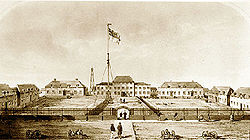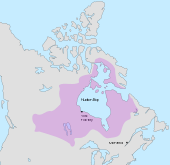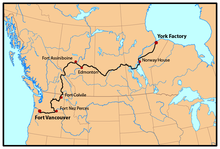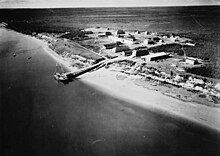York Factory
| York Factory | |
|---|---|
 York Factory in 1853 | |
| Location | Manitoba,Canada |
| Area | 102 hectares (250 acres) |
| Founder | Hudson's Bay Company |
| Built | 1788 to 1850 |
| Original use | Fort,military structure,fur tradingpost |
| Governing body | Parks Canada |
| Website | parks |
| Designated | 1936 |
York Factorywas a settlement andHudson's Bay Company(HBC)factory (trading post)on the southwestern shore ofHudson Bayin northeasternManitoba,Canada, at the mouth of theHayes River,approximately 200 kilometres (120 mi) south-southeast ofChurchill.
York Factory was one of the first fur-trading posts established by the HBC, built in 1684 and used in that business for more than 270 years. The settlement was headquarters of the HBC's Northern Department from 1821 to 1873.[1]The complex was designated aNational Historic Site of Canadain 1936.[2]
In 1957, the HBC closed it down. It has been owned by the Canadian government since 1968 and the site is now operated byParks Canada.No one lives permanently at York Factory; there is a summer residence for Parks Canada staff, and some nearby seasonal hunting camps. The wooden structure at the park site dates from 1831 and is the oldest and largest wooden structure built onpermafrostin Canada.
Location
[edit]York Factory is on the north bank of the Hayes River about 11 kilometres (7 miles) inland. The mouth of theNelson Riveris to the north, across "Point of Marsh". The Hayes is a more practical canoe route, although the Nelson is much larger (it drains Lake Winnipeg). Seagoing ships anchored at Five Fathom Hole 11 km (7 mi) from the fort due to the shallow bottom, and goods weretransferred by smaller boats.TheShamattawa AirportandGillam Airportare nearby today.[3]
History
[edit]





From the 17th to the late 19th century, the depot at York Factory and its predecessors were the central base of operations for the Hudson's Bay Company's (HBC) control of thefur tradeand other business dealings with theFirst NationsthroughoutRupert's Land,the vast territory comprising the entire watershed of Hudson Bay, and which now forms much of Canada.
The first three HBC posts were established onJames Bayabout 1670. In 1684,Fort Nelson,a fur trading post at the mouth of the Nelson River and the first headquarters of the Hudson's Bay Company, was established at the mouth of the nearbyNelson River.The company built a second fort, York Factory, on the Hayes river, naming it after theDuke of York.The establishment of the forts provoked a response fromNew France.In theHudson Bay expedition (1686),the French marched overland from Quebec and captured all the posts on James Bay. DuringKing William's War,France several times sent a naval force toHudson Bayto capture or destroy the fort. In 1690,Pierre Le Moyne d'Ibervilletried but was driven away by a larger English ship. In 1694, d'Iberville returned andcaptured York Factorywith a show of force. He renamed it Fort Bourbon. English forces returned the next year and retook the fort from its small French garrison. In 1697, d'Iberville won theBattle of Hudson's Bay,the largestArcticnaval battle in North American history. The French force won in the naval battle with threeEnglishwarshipsand again captured York Factory since d'Iberville had laid siege to the fort in such a way as to give the appearance of having a much stronger force. York Factory was held by the French until 1713, when it was returned to theBritishin theTreaty of Utrecht.The HBC then again placed its northern headquarters at York Factory, at the mouth of the Hayes River.
From 1788 to 1795, the company constructed a squarebastion fortof stone and brick at York Factory. The fort was known as The Octagon” because of the octagonal shape of the area enclosed. The choice of material was poor, however, as the stone and brick could not stand up to heaving permafrost, and in 1831, the stone fort was razed. The three-story center section of the current compound was completed that same year, with the two-story wings finished within the two years that followed.
During its first century, the depot operated by drawing First Nations traders to the post, rather than sending its own traders out into the field. Its position at the mouth of the Nelson allowed access bycanoefrom the watersheds of theSaskatchewanandRedrivers.
In the late 18th century, the centralized nature of theHudson's Bay Company's operation from the depot began to become a disadvantage against the more nimblevoyageursof theNorth West Company.They operated by travelling among the First Nations on the vast water network of lakes and rivers. In response, the company began sending out its own traders from the depot and eventually established inland posts, first along the Saskatchewan River, and then stretching as far as theOregon Country.Twice annually from 1821 to 1846, brigades known as theYork Factory Expresstravelled overland toFort Vancouverheadquarters for the HBC'sColumbia Department,brought supplies and trade goods,and returned with furs destined for London.
By the mid-19th century, York Factory had developed an extensive trading post and settlement with 50 on-site buildings, most of which have been destroyed, and a permanent workforce. However, it was not a beloved location. The chief trader,John McLean,wrote that he "took leave of Fort York, its fogs, and bogs and mosquitoes, with little regret" in 1837.[4]Moreover, the reign of York Factory as one of the most important Hudson's Bay Company posts declined in 1860s and 1870s because of the transfer of Rupert's Land to Canada and the changes in the HBC Northwest transportation network that increased the use of the United States railways, steamboats, and Red River carts forUpper Fort Garry's southern supply line. The depot remained in company hands after the acquisition of Rupert's Land byCanadain 1870. In 1872, York Factory's role diminished to outfitting only to particular posts in Manitoba. The post's fur trade headquarters title was removed a year later, and certain responsibilities were transferred to Upper Fort Garry, present-dayWinnipeg.[5]
The importance of York Factory declined further. From 1874 to 1875, the post virtually stopped receiving supplies and goods to be transported elsewhere. The following years, specifically 1878, the post's British products began being relocated toNorway House.[6]York Factory had a brief upswing when it was designated the headquarters for the new Nelson River District in 1911. However, the Factory lost the title in 1929 to Churchill due to the establishment of the railway line that connected Churchill to Winnipeg. From that point forward, York Factory served as a regional trading post.[5]
In 1957, Hudson's Bay York Factory closed. The residents were relocated toYork Landing Cree Nation,[7]about 116 kilometres (72 mi) ENE ofThompson, Manitoba,as well as Split Lake and Shamattawa. In oral stories, Cree elders who once resided at York Factory in the first half of the twentieth century recalled their desires to remain at Kihci-waskahikan or Great House when operations ceased. Kihci-waskahikan and Great House are words for the post used by the Swampy Cree, West Main Cree, Lowland Cree, and/or Home Guard Cree.[8]
The historic site is currently staffed by Parks Canada from June 1 to mid-September. Archaeological excavations of the 18th-century "octagon" have been conducted since 1991.
See also
[edit]- Battle of York Factory
- York Factory Express
- North American fur trade
- North-West Mounted Police in the Canadian north
References
[edit]- ^Pannekoek, Frits (February 7, 2006)."York Factory".The Canadian Encyclopedia(online ed.).Historica Canada.RetrievedOctober 5,2015.
- ^York Factory National Historic Site of Canada.Canadian Register of Historic Places.Retrieved 6 December 2016.
- ^"About Us".Archived fromthe originalon January 16, 2016.RetrievedJune 8,2014.
- ^Boyle, David (1892),"Notes on the Discoverer of the Great Falls of Labrador",Transactions of the Canadian Institute,vol. II, Toronto: Copp, Clark Co, p. 335.
- ^abBeardy, Flora; Coutts, Robert, eds. (1996).Voices from Hudson Bay: Cree Stories from York Factory.Montréal: McGill-Queen's University Press. p. xxi.ISBN0-7735-1440-6.RetrievedOctober 5,2015.
- ^Innis, Harold A.(2001) [1930].The Fur Trade in Canada: An Introduction to Canadian Economic History(reprint ed.). Toronto, Ontario: University of Toronto Press. p. 341.ISBN0-8020-8196-7.RetrievedOctober 5,2015.
- ^"About Us".York Factory First Nation.Archived fromthe originalon March 22, 2012.RetrievedMay 16,2011.
- ^Beardy & Coutts (1996),pp. xi & xvi
Secondary sources
[edit]- Newman, Peter C. (1998).The Empire of the Bay.
External links
[edit]- French forts in Canada
- Fur trade
- Ghost towns in Manitoba
- Hudson's Bay Company trading posts in Manitoba
- Localities in Manitoba
- National Historic Sites in Manitoba
- Populated places on Hudson Bay
- Populated places established in 1684
- Populated places disestablished in 1957
- 1957 disestablishments in Manitoba
- 1684 establishments in North America
- Buildings and structures in Northern Region, Manitoba
- Populated places in Northern Region, Manitoba
